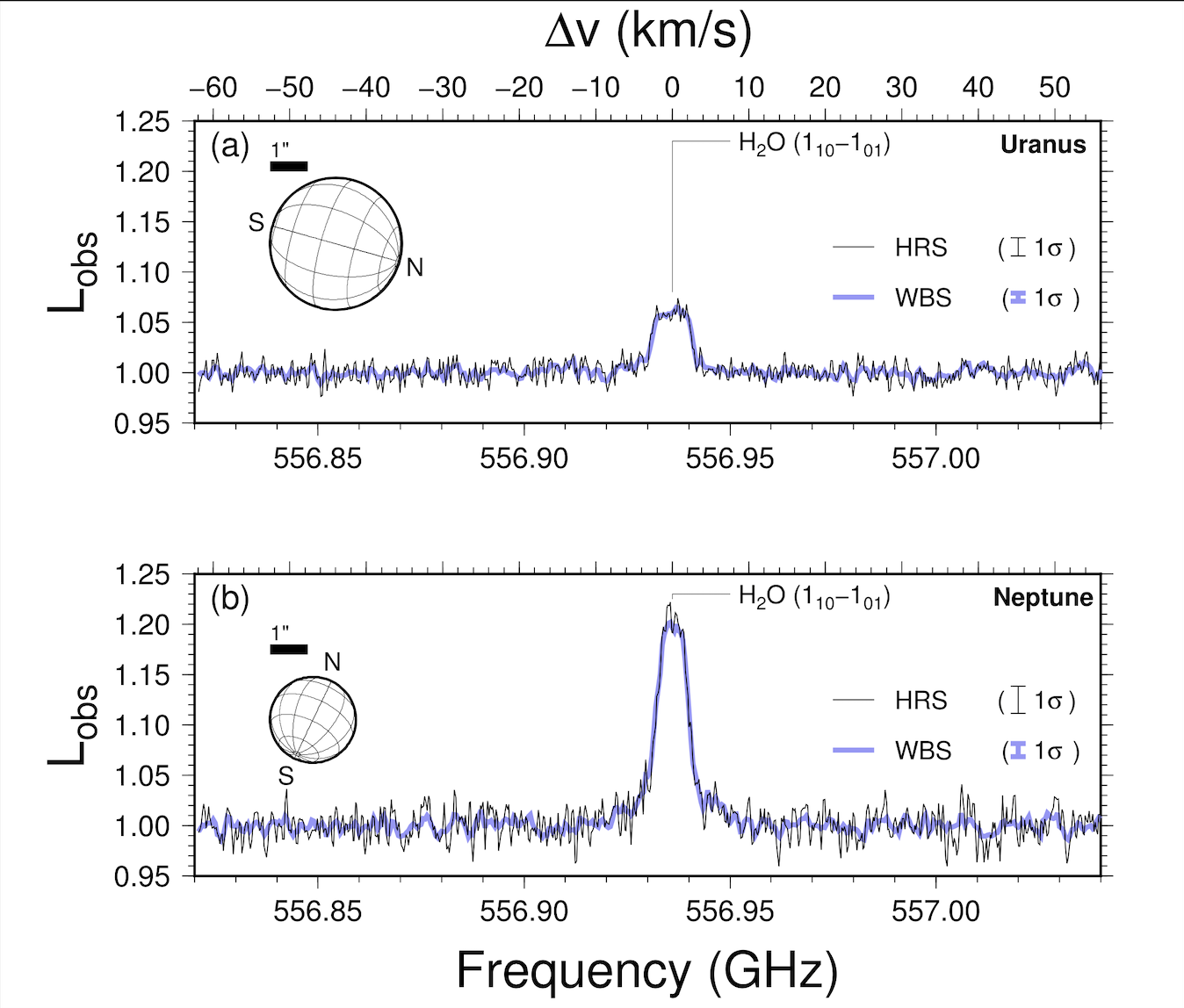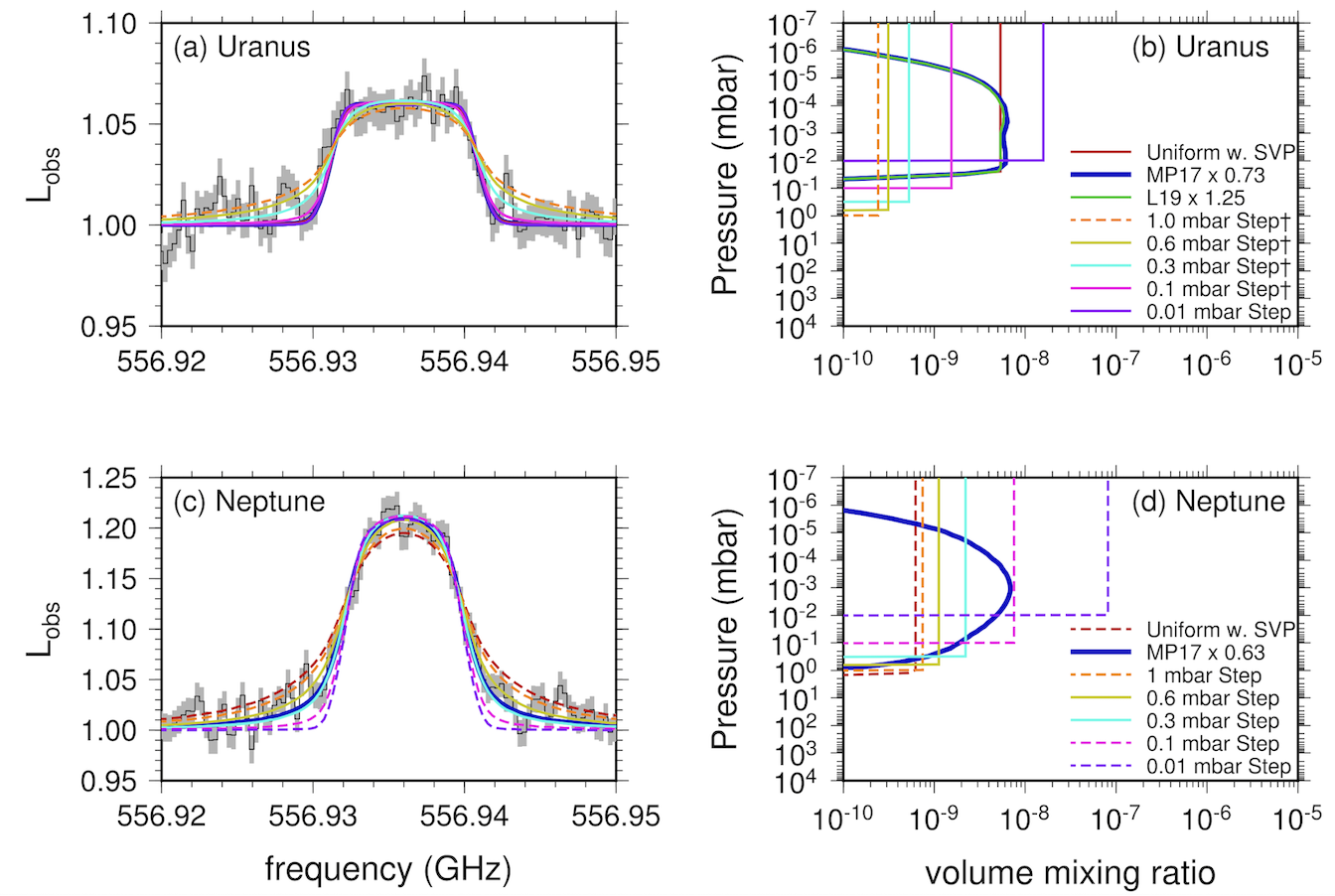Uranus and Neptune's stratospheric water abundance and external flux from Herschel-HIFI
- 1School of Earth Sciences, University of Bristol, Bristol, UK (n.teanby@bristol.ac.uk)
- 2Atmospheric, Oceanic & Planetary Physics, Department of Physics, University of Oxford, Oxford, UK
- 3Solar System Exploration Division, NASA Goddard Space Flight Center, Greenbelt, USA
- 4Solar System Exploration Division, NASA Goddard Space Flight Center, Greenbelt, USA; Department of Physics, Catholic University of America, Washington DC, USA
Water vapour in the stratospheres of Uranus and Neptune has previously been shown to originate from external sources. These sources could include comet impacts [4], interplanetary dust particles [8], or rings and moons [1]. Stratospheric water was first detected on Uranus and Neptune by the Short-Wavelength Spectrometer (SWS) on the Infrared Space Observatory (ISO) [2], but the uncertainties were relatively large due to lack of constraint on the vertical water profiles and relatively low spectral resolution of the observations.
Here we present new observational constraints on Uranus’ and Neptune’s externally sourced stratospheric water abundance using disc-averaged high spectral resolution observations of the 557 GHz water emission line from Herschel’s Heterodyne Instrument for the Far-Infrared (HIFI). On both planets the emission line is significantly broadened by disc-averaging of Doppler shifts from planetary rotation, which was carefully accounted for in our analysis [10]. Derived stratospheric column water abundances are 0.56+0.26-0.06 x 1014 cm-2 for Uranus and 1.9+0.2-0.3 x 1014 cm-2 for Neptune. These results imply Neptune has about four times as much stratospheric water as Uranus, and are consistent with previous determinations from ISO-SWS and Herschel-PACS, but with improved precision.
For Uranus excellent observational fits are obtained by scaling photochemical model profiles [3,7] or with step-type profiles with water vapor limited to <=0.6mbar. However, Uranus’ cold stratospheric temperatures imply a ~0.03mbar condensation level, which further limits water vapor to pressures <=0.03 mbar. Neptune’s warmer stratosphere has a deeper ~1 mbar condensation level, so emission-line pressure broadening can be used to further constrain the water profile. For Neptune, excellent fits are obtained using step-type profiles with cutoffs of ~0.3-0.6 mbar or by scaling a photochemical model profile [7]. Step-type profiles with cutoffs >=1.0 mbar or <=0.1 mbar can be rejected with 4σ significance. Rescaling photochemical model profiles from [7] to match our observed column abundances implies similar external water fluxes for both planets: 8.3+4.0-0.9 x 104 cm-2s-1 for Uranus and 12.7+1.3-2.0 x 104 cm-2s-1 for Neptune.
This inferred water influx rates suggest that Uranus and Neptune may in fact have very similar IDP fluxes, unless there are significant water-loss processes that are not accounted for in current photochemical models [3,7]. This is unexpected as the IDP flux on Neptune is expected to be higher due to its closer proximity to the Kuiper belt. For example, the dynamical model of [8] predicts that the flux of IDP grains is around seven times higher on Neptune than on Uranus, but model uncertainties are large enough so as not to preclude a similar flux. The comet impact rates on Uranus and Neptune are also predicted to be quite similar [5,11], so both planets may experience similar external flux processes.
Our new analysis suggests that Neptune’s approximately four times greater observed water column abundance is primarily caused by its warmer stratosphere preventing loss by condensation, rather than by a significantly more intense external source. Larger error bars on the Uranus estimates are due to greater uncertainty in the high-altitude temperature profile. To reconcile these water fluxes with other observed stratospheric oxygen species (CO and CO2) requires either a significant CO component in interplanetary dust particles (Uranus) or contributions from cometary impacts (Uranus, Neptune). In particular, the large CO abundance in Neptune’s stratosphere suggests that we just happen to be observing Neptune at a time shortly after a large comet impact [4,6,9].
Further details of our results and analysis are available in our recent publication [10].

Fig1: Herschel-HIFI line-to-continuum ratio spectra of the 557GHz water line for HRS and WBS spectrometers. The water line is clearly visible at high signal to noise on both planets, but the line is broadened due to Doppler shift combined with the disc-broadened nature of the HIFI spectra. (Figure from https://doi.org/10.3847/PSJ/ac650f, see reference [10]).

Fig2: Fits to Uranus and Neptune HIFI-HRS spectra 557GHz water line. (a,b) Uranus can be fitted with step profiles with a step pressure less than ~0.6mbar or by scaling photochemical profiles. However, significant water vapour is unlikely at pressures above ~0.03mbar due to saturation. (c,d) Neptune can be fitted with step profiles with a step in the pressure range 0.3-0.6mbar or by scaling photochemical profiles. (Figure from https://doi.org/10.3847/PSJ/ac650f, see reference [10]).
References
[1] Cavalié+ 2019. https://ui.adsabs.harvard.edu/abs/2019A%26A...630A..87C/abstract
[2] Feuchtgruber+ 1997. https://ui.adsabs.harvard.edu/abs/1997Natur.389..159F/abstract
[3] Lara+ 2019. https://ui.adsabs.harvard.edu/abs/2019A%26A...621A.129L/abstract
[4] Lellouch+ 2005. https://ui.adsabs.harvard.edu/abs/2005A%26A...430L..37L/abstract
[5] Levison 2000. https://ui.adsabs.harvard.edu/abs/2000Icar..143..415L/abstract
[6] Moreno+ 2017. https://ui.adsabs.harvard.edu/abs/2017A%26A...608L...5M/abstract
[7] Moses+Poppe 2017. https://ui.adsabs.harvard.edu/abs/2017Icar..297...33M/abstract
[8] Poppe 2016. https://ui.adsabs.harvard.edu/abs/2016Icar..264..369P/abstract
[9] Teanby+ 2019. https://ui.adsabs.harvard.edu/abs/2019Icar..319...86T/abstract
[10] Teanby+ 2022. https://ui.adsabs.harvard.edu/abs/2022PSJ.....3...96T/abstract
[11] Zahnle 2003. https://ui.adsabs.harvard.edu/abs/2003Icar..163..263Z/abstract
How to cite: Teanby, N., Irwin, P., Nixon, C., Cordiner, M., and Wright, L.: Uranus and Neptune's stratospheric water abundance and external flux from Herschel-HIFI, Europlanet Science Congress 2022, Granada, Spain, 18–23 Sep 2022, EPSC2022-168, https://doi.org/10.5194/epsc2022-168, 2022.

